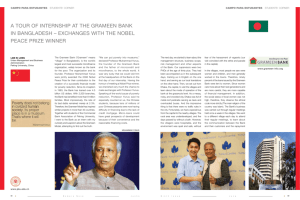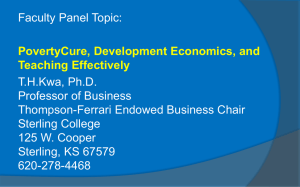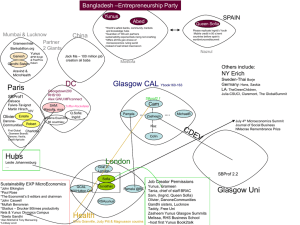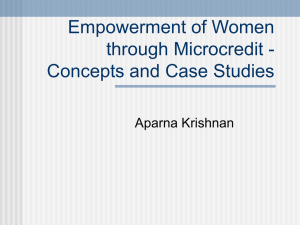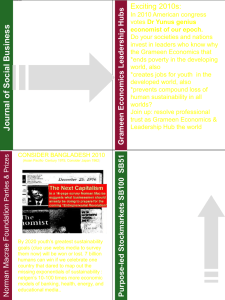muhammad yunus - Robert F. Kennedy Center for Justice & Human
advertisement
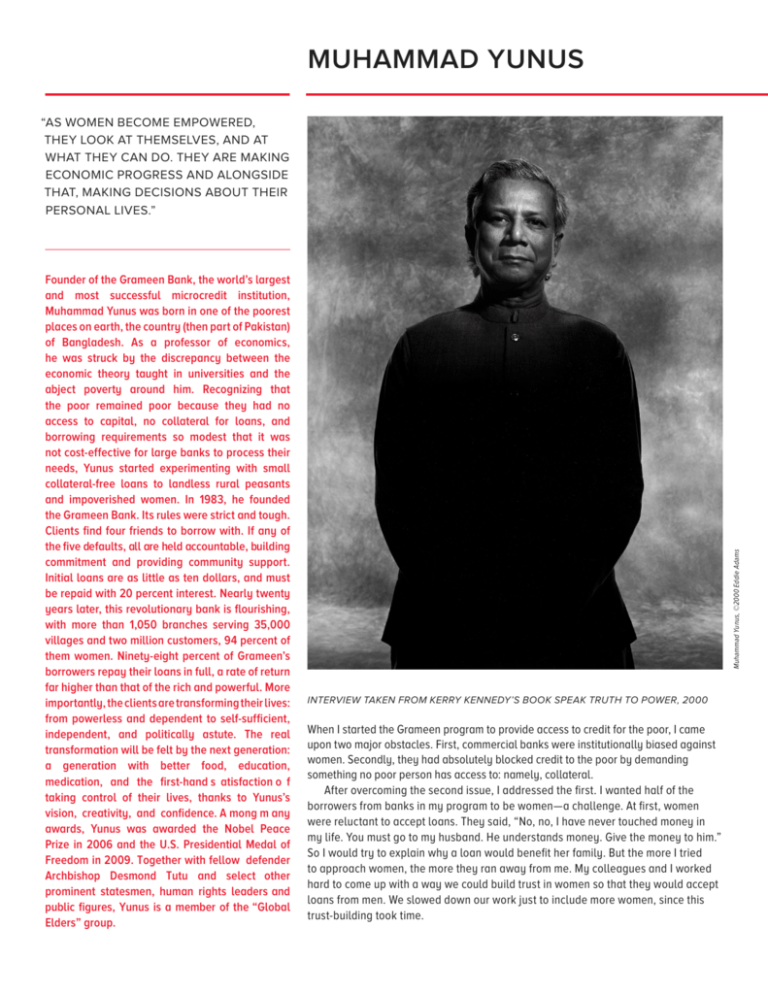
MUHAMMAD YUNUS
Founder of the Grameen Bank, the world’s largest
and most successful microcredit institution,
Muhammad Yunus was born in one of the poorest
places on earth, the country (then part of Pakistan)
of Bangladesh. As a professor of economics,
he was struck by the discrepancy between the
economic theory taught in universities and the
abject poverty around him. Recognizing that
the poor remained poor because they had no
access to capital, no collateral for loans, and
borrowing requirements so modest that it was
not cost-effective for large banks to process their
needs, Yunus started experimenting with small
collateral-free loans to landless rural peasants
and impoverished women. In 1983, he founded
the Grameen Bank. Its rules were strict and tough.
Clients find four friends to borrow with. If any of
the five defaults, all are held accountable, building
commitment and providing community support.
Initial loans are as little as ten dollars, and must
be repaid with 20 percent interest. Nearly twenty
years later, this revolutionary bank is flourishing,
with more than 1,050 branches serving 35,000
villages and two million customers, 94 percent of
them women. Ninety-eight percent of Grameen’s
borrowers repay their loans in full, a rate of return
far higher than that of the rich and powerful. More
importantly, the clients are transforming their lives:
from powerless and dependent to self-sufficient,
independent, and politically astute. The real
transformation will be felt by the next generation:
a generation with better food, education,
medication, and the first-hand s atisfaction o f
taking control of their lives, thanks to Yunus’s
vision, creativity, and confidence. A mong m any
awards, Yunus was awarded the Nobel Peace
Prize in 2006 and the U.S. Presidential Medal of
Freedom in 2009. Together with fellow defender
Archbishop Desmond Tutu and select other
prominent statesmen, human rights leaders and
public figures, Yunus is a member of the “Global
Elders” group.
Muhammad Yunus, ©2000 Eddie Adams
“AS WOMEN BECOME EMPOWERED,
THEY LOOK AT THEMSELVES, AND AT
WHAT THEY CAN DO. THEY ARE MAKING
ECONOMIC PROGRESS AND ALONGSIDE
THAT, MAKING DECISIONS ABOUT THEIR
PERSONAL LIVES.”
INTERVIEW TAKEN FROM KERRY KENNEDY’S BOOK SPEAK TRUTH TO POWER, 2000
When I started the Grameen program to provide access to credit for the poor, I came
upon two major obstacles. First, commercial banks were institutionally biased against
women. Secondly, they had absolutely blocked credit to the poor by demanding
something no poor person has access to: namely, collateral.
After overcoming the second issue, I addressed the first. I wanted half of the
borrowers from banks in my program to be women—a challenge. At first, women
were reluctant to accept loans. They said, “No, no, I have never touched money in
my life. You must go to my husband. He understands money. Give the money to him.”
So I would try to explain why a loan would benefit her family. But the more I tried
to approach women, the more they ran away from me. My colleagues and I worked
hard to come up with a way we could build trust in women so that they would accept
loans from men. We slowed down our work just to include more women, since this
trust-building took time.
Six years later, proud that half our loans were to women,
we began to see something very remarkable. Money that went
to families through women helped the families much more than
the same amount of money going to men. Unlike men, women
were very cautious with money and passed benefits on to their
children immediately. They had learned how to manage with
scarce resources. And women had a longer vision; they could see a
way out of poverty and had the discipline to carry out their plans.
Perhaps because women suffer so much more from poverty than
men, they are more motivated to escape it.
In contrast, men were looser with money. They wanted to enjoy
it right away, not wait for tomorrow. Women were always building
up things for the future, for themselves, their children, their families.
We saw a number of such differences between men and women.
We decided to make a concerted effort to attract women clients
because we got much more mileage out of the same amount of
money. So I created incentives for our loan officers because they
had such a hard time convincing women to borrow money from the
bank. Today, 94 percent of our loans go to women.
It has worked in ways we never anticipated. For instance,
women borrowers decided to commit themselves to a set of
promises that they called the “sixteen decisions.” These are
commitments to improve the welfare of the borrowers and their
families above and beyond the loans. They agreed to send their
children to school, they decided to maintain discipline, to create
unity, to act with courage, and to work hard in all their endeavors.
They agreed to keep their families small, to send their children
to school, to plant as many seedlings as possible, even to eat
vegetables. These are some of the resolutions created by the
women, not imposed by the bank. These aspirations were critical
to their lives. Listening to them, you see what a difference women
make.
A typical initial loan is something like thirty-five dollars. The
night before a woman is going to accept that money from the
bank, she will be tossing and turning to decide whether she is
really ready for it. She is scared that maybe something terrible will
happen to her. And finally in the morning her friends will come over
and they will try to persuade her: “Let’s go through with it. If you
don’t go, we can’t. We can’t always worry. It was not easy coming
to this point. Let’s go.” And finally, with their encouragement, she
will come to the bank.
When she holds that money, it is such a huge amount in her
hands, it is like holding the hope and treasure that she never
dreamt she would achieve. She will tremble, tears will roll down her
cheeks, and she won’t believe we would trust her with such a large
sum. And she promises that she will pay back this money, because
the money is the symbol of the trust put in her and she does not
want to betray that trust.
And then she struggles to pay that first loan, that first
installment, which is due the following week, and the second
installment, which is payable the following week, and this goes
on for fifty weeks in sequence, and every time that she repays
another installment she is braver! And when she finishes her
fiftieth installment, the last one, and she has now paid in full, she
can say, “I did it!” She wants to celebrate. It’s not just a monetary
transaction that has been completed, it is nothing less than a
transformation of that person. In the beginning of it all, she was
trembling, she was tossing and turning, she felt she was nobody
and she really did not exist. Now she is a woman who feels like
she is somebody. Now she can almost stand up and challenge the
whole world, shouting, “I can do it, I can make it on my own.” So
it’s a process of transformation and finding self-worth, self-esteem.
Proving that she can take care of herself.
You see, if you only look at the lending program of Grameen, you
have missed most of its impact. Grameen is involved in a process of
transformation. The sixteen decisions is an example: we found that
Grameen children attend school in record numbers because their
mothers really take that commitment seriously. And now many of the
children are continuing in colleges, universities, going on to medical
schools, and so on. It is really striking to see young boys and girls go
on to higher levels of education. The program has been so successful
that we now foresee a big wave of students needing loans, so
we recently came up with another loan product to finance higher
education for all Grameen children in professional schools. Now they
don’t have to worry about whether their parents will be able to pay
for their higher education when tuition is so expensive.
A recent study in Bangladesh showed that children in Grameen
families are healthier than non-Grameen children. Scientific
American did a study of population growth in Bangladesh showing
that the average number of children per family twenty years back
was seven, but now it has been reduced to three. What happened?
Why did it happen? Scientific American has spurred controversy
by claiming the change is due to our program. As women become
empowered, they look at themselves and at what they can do.
They are making economic progress and alongside that, making
decisions about their personal lives and how many children they
choose to have. And of course Article 16, Decision 1, says that we
should keep our families small. So this is an important part of the
equation. At the population summit in Cairo all the sessions spoke
of the Grameen model, because the adoption of family planning
practices of women in our program is twice as high as the national
average. Now, we are not a population program, but this is a
beneficial side effect.
There are other side effects. Starting seven years back we
encouraged Grameen borrowers to participate in the political
process by voting. Their first reaction was negative. They said, “The
candidates are all devils, so why should we vote for them?” It was
very depressing that people looked at their electoral process in that
way.
So we replied, “Okay, yes, they are all devils, but if you don’t
go and vote, the worst devil will get elected. So go sit down in
your centers, discuss who could be the worst, what could happen
if he gets elected, and if you find this prospect terrible, then you
have an opportunity to choose among all the devils, the least evil.”
People immediately got excited, and we had almost 100 percent
participation in that first election.
It was very well organized. All the Grameen families met the
morning of the elections, and went to the voting place together, so
the politicians would take note of their large numbers, so that they
were taken seriously. In the next elections we organized Grameen
families to vote themselves and also to bring their friends and
neighbors to vote, particularly the women.
The result was that in the 1996 election in Bangladesh voter
participation was 73 percent, the highest percentage ever. And
what shocked everybody was that across the board more women
voted than men. In fact, women waited for hours, because when the
voting arrangements were made, the authorities had expected only
half the number to show up.
The outcome changed the political landscape. In the previous
parliament, the fundamentalist religious party had seventeen seats;
in the 1996 election, their number was reduced to three, because
women found nothing interesting in the fundamentalist party’s
program. So that was very empowering, very empowering indeed.
Then, in last year’s local elections, we were shocked to see
that many Grameen members themselves got elected. So I went
around and talked to those people, and asked why they chose
to run for office. They said, “You told us to select the least of the
devils, and we tried, but it was such an ugly job that we got fed up,
and we started looking at each other, thinking, ’Why are we looking
for the least devil, when we are good people here? Why don’t we
run ourselves?” And that started the snowball effect which ended
with more than four thousand Grameen members elected into
local office. That’s amazing. And the way they talk is completely
different. I never heard women in Bangladesh talking like this.
They are challenging the government. They say, “The government
can’t tell us how to vote. We made commitments to our electorate.”
This is the kind of thing that happens. So in health care, in political
participation, in the relationship between mother and child and
between husband and wife, there are transformations of society.
Now you can open up, you can do things, you can discover
your own talent and ability and look at the world in a very different
way than you looked at before. Because Grameen offers a chance
to become part of an institution, with some financial support
to do your own thing. Our customers are in a kind of business
relationship, but one that makes such a difference to their lives.
Of course there is resistance. The first resistance came from
the husbands who felt insulted, humiliated, threatened that their
wives were given a loan and they were not. The tension within the
family structure sometimes led to violence against the women. So
we paused for a while and then came up with an idea. We started
meeting with the husbands and explaining the program in a way
where they could see it would be beneficial to their family. And we
made sure to meet with husbands and wives together so everyone
understood what was expected. So that reduced a lot of initial
resistance by the husbands.
Neighborhood men also raised objections, and cloaked the fact
that they felt threatened by women’s empowerment in religious
trappings. We carefully examined whether our program was in some
way antireligious. But they were hiding behind religion instead of
admitting that they felt bypassed. It was the male ego speaking in
religious terms.
Our best counterargument was just to give it time. It soon
became clear that our borrowers were still attending to their
religious duties, at the same time earning money and becoming
confident. Women started confronting the religious people. They
said, “You think taking money from Grameen Bank is a bad idea?
Okay, we won’t take any more—if you give the money yourself.
We don’t care who gives it to us, but without money we cannot do
anything.” And of course the religious advocates said, “No, no, we
can’t give you money.” So that was the end of that.
We also received criticism from development professionals
who insisted that giving tiny loans to women who do not have
knowledge and skill does not bring about structural change in the
country or the village and therefore is not true development at
all. They said development involves multimillion dollar loans for
enormous infrastructure projects. We never expected opposition
from the development quarter, but it happened, and became
controversial. Because what we do is not in their book. They cannot
categorize us, whether right, left, conservative, or liberal. We talk
free market, but at the same time we are pro-poor. They are totally
confused.
But if you are in a classroom situation, you wander around
your abstract world, and decide microcredit programs are silly
because they don’t fit into your theoretical universe. But I work
with real people in the real world. So whenever academics or
professionals try to draw those conclusions, I get upset and go
back and work with my borrowers—and then I know who is right.
The biggest smile is from one of those women who has just
changed her existence. The excitement she experienced with her
children, moving from one class to another, is so touching, so real
that you forget what the debate was in the ballroom of the hotel
with all the international experts, telling you that this is nothing. So
that’s how I’ve got the strength—from people.
Grameen Bank is now all over Bangladesh, with 2.4 million
families. Even in hard times, like this year’s terrible flood, people
are willingly paying and we’re getting really good loans. That
demonstrated the basic ability of the people to do something
that they believe in, no matter what others say. People ask,
what is the reason that we succeeded, that we could do it, when
everybody said it couldn’t be done. I keep saying that I was
stubborn. So when you ask if it took courage, I would instead say
it took stubbornness. No matter what kind of beautiful explanation
you give, that’s what it takes to make it happen.
COMBATING POVERTY
MUHAMMAD YUNUS
LESSON GRADE LEVEL: 6–8
HUMAN RIGHTS ISSUE: MICROCREDIT
UNIVERSAL DECLARATION OF
HUMAN RIGHTS:
VOCABULARY:
• Article 23: Right to Desirable Work
• Article 25: Right to Adequate Living
Standard
TIME REQUIREMENT: 160 minutes
OBJECTIVES:
After this lesson, students will be able to:
• Describe “poverty” and its long-reaching
effects.
• Identify factors contributing to the cycle of
poverty.
• Understand banks’ traditional “3Cs”
approach to lending money.
• Understand Muhammad Yunus’s
microcredit approach.
• Analyze the benefits of microcredit as well
as the challenges it faces.
GUIDING QUESTIONS:
• What does it mean to live in poverty?
• What are poverty’s far-reaching effects?
• How can we make poverty a thing of
•
•
•
•
•
•
•
TECHNOLOGY REQUIRED:
• Internet for video clips
MATERIALS:
• Chart paper or interactive whiteboard
•
•
•
•
the past?
COMMON CORE LEARNING
STANDARDS:
•
•
•
•
•
CCSS.ELA-LITERACY.RH.6-8.1
CCSS.ELA-LITERACY.RH.6-8.4
CCSS.ELA-LITERACY.RH.6-8.7
CCSS.ELA-LITERACY.WHST.6-8.7
CCSS.ELA-LITERACY.WHST.6-8.9
CONCEPTS:
•
•
•
•
•
•
•
•
•
•
Economic systems
Values
Choice
Empathy
Needs and wants
Factors of production
Justice
Decision-making
Civic values
Human rights
Poverty
Bank loans
Credit
The 3 Cs
Collateral
Microcredit
Grameen Bank
•
•
http://blogs.nysut.org/sttp/files/2010/11/
speaktruth_yunus.pdf
May I Have a Loan worksheet
http://blogs.nysut.org/sttp/files/2010/11/
speaktruth_yunus.pdf
Activity 1 Reflection Sheet (PDF)
Video clip: Pennies a Day
http://www.YouTube.com/
watch?v=veaVikY3u98
Activity 2 Reading for Information: taken
from What is Microcredit? Grameen Bank
-Banking for the Poor, July, 2010
http://www.grameen-info.org/?s=What+i
s+microcredit%3F&x=0&y=0
STTP reading: Muhammad Yunus
www. RFKHumanRights.org / click
on Speak Truth to Power / click on
“Defenders” tab
Video clip: UNICEF: Microfinance
Promoting Women in Togo
http://www.teachertube.com/video/
unicef-microfinance-promotingwomen-in-togo-181245
Speak Truth To Power | 4
STUDENT ACTIVITIES
ANTICIPATORY SET:
• Introduce the following questions to the class, telling the students
these are the guiding questions for the next lesson:
{{What does it mean to live in poverty?
{{What are poverty’s far-reaching effects?
{{How can we make poverty a thing of the past?
• Conduct a short class discussion, brainstorming a definition or
description of “poverty” and how it impacts people’s lives.
{{Record students’ answers on chart paper or interactive
whiteboard to refer to during the unit.
• Show students the website on poverty:
http://www.globalissues.org/article/26/poverty-facts-and-stats
• Ask students for ideas on ways to end poverty. Lead the class to
the conclusion that those in poverty need money to improve their
lives. One place to borrow money is from a bank.
ACTIVITY 1:
• Divide students in small groups. Each group is to pretend they are
a group of bank managers in charge of giving out loans.
• Distribute May I Have a Loan? worksheets to each group.
http://blogs.nysut.org/sttp/files/2010/11/speaktruth_yunus.pdf
• Review the indicators banks generally look at in order to determine
if a person qualifies for a loan, called the 3Cs, or one’s Character,
Capital [or Collateral], and Capacity.
• Instruct the groups to discuss the pros and cons of giving the
people described on the worksheet bank loans.
• When finished with the exercise ask students to share with the
class their decision, identifying whether they would be approving
the loan.
• The teacher will wrap up this class discussion by going back to the
earlier discussion and the essential questions: How can we make
poverty a thing of the past if banks don’t give people loans? Are
there any other ideas or solutions?
• Ask students to reflect upon Yunus’s approach to loaning money to
the poor and their own approach in Activity1.
{{How is Yunus’s idea different from traditional lending
practices?
{{What were the benefits to Yunus’s ideas?
• Distribute Activity 2: Reading for Information
http://www.muhammadyunus.org/index.php/design-lab/
previous-design-labs/43-news-a-media/books-a-articles/232is-grameen-bank-different-from-conventional-banks
on the Grameen Bank. The teacher may differentiate the lesson
based upon reading levels:
{{Reading A (taken from What is Microcredit? Grameen BankBanking for the Poor, July 2010 is for lower-level readers:
http://www.grameen-info.org/?s=What+is+microcredit%3
F&x=0&y=0
{{Reading B (taken from Is Grameen Bank Different from
Conventional Banks? Grameen Bank-Banking for the Poor,
July 2010 is for stronger readers:
http://www.grameen-info.org/is-grameen-bank-differentfrom-conventional-banks/
{{Students could read independently, or the teacher may
create groups of students of mixed reading abilities and
have the students work together.
• After reading articles, students are to complete the assignments
described on Activity 2: Reading for Information worksheets
including the creation of a Venn diagram comparing and
contrasting the two banking systems.
• Students will write a response to the following question:
{{Do banks have a responsibility to help to end poverty?
{{Should changes be made to loan practices today?
ACTIVITY 3:
• Review students’ Venn diagrams and written responses on the
HOMEWORK:
• Students should reflect upon their work in class by reviewing their
initial answers to the May I Have a Loan? worksheet. Students
should complete the Activity 1 Reflection Sheet: What I’ve Learned
by writing a paragraph in response to the following questions:
{{Why can’t the poor get bank loans?
{{What other ideas or solutions can you think of to address
this problem?
•
•
•
ACTIVITY 2:
• Review Activity 1 Reflection Sheet answers in a class discussion,
summarizing the main problem—how the lack of credit given to the
poor continues the cycle of poverty. Discuss students’ answers on
how to break the cycle.
• Show the class the video clip Pennies a Day, introducing
Muhammad Yunus and the Grameen Bank.
http://www.YouTube.com/watch?v=veaVikY3u98
5 | Speak Truth To Power
•
•
Activity 2: Reading for Information worksheet. Allow students from
each reading group to share information.
Distribute Speak Truth To Power reading on Muhammad Yunus to
be read as a class: www. RFKHumanRights.org / click on Speak
Truth to Power / click on “Defenders” tab
Review both the idea that microcredit banking is helping to end the
cycle of poverty and the unit’s guiding questions.
Show the video clip UNICEF: Microfinance Promoting Women in
Togo to further help students see the benefits of microcredit on
poor women’s lives.
http://www.teachertube.com/video/unicef-microfinancepromoting-women-in-togo-181245
Ask students to revisit their initial responses to the guiding
questions:
{{What does it mean to live in poverty?
{{What are poverty’s far-reaching effects?
Ask students to respond to the following questions in a class
discussion:
{{When economic problems are solved, what are the domino
results?
{{How might microcredit help make poverty a thing
of the past?
Students should choose one of the following activities.
• Students should reflect upon Muhammad Yunus’s new approach to
combating the age-old problem of poverty. How will students let
others know about what they have learned? Students can create
a written or visual piece (artwork, PowerPoint, or movie) to share
with family members.
{{Students should be encouraged to “think outside the box”
as Yunus did—how can they spread his message in a unique
and powerful way? Show students the video clip Human
Rights Article 28 A Fair and Free World as a model
http://www.youthforhumanrights.org/what-are-humanrights/videos/fair-and-free-world.html
EXPANDING OPPORTUNITIES:
• Ask students: Do you think the microcredit concept would work in
other places? Would it work in the U.S.? Why or why not?
• Distribute the April 1, 2008, New York Times article “Lending Plan
Won Prize, but Will It Work Here? ” for class reading.
• What special challenges does the Grameen system face
in the U.S.? http://www.nytimes.com/2008/04/01/
nyregion/01grameen.html?_r=2&pagewanted=2
• Distribute the July 8, 2010, Newsweek article “The Poor Always
Pay.” This includes an update on Grameen in the U.S. Discuss: Does
the bank seem to be progressing? Why/why not?
http://www.newsweek.com/grameen-bank-expandsamerica-74497
• Students can investigate microfinancing groups and then vote on
an organization to support. They can then start a class fund-raising
project such as hosting a hunger banquet to earn money to make
a loan.
{{Women’s Trust, Pokuse, Ghana
http://www.womenstrust.org/
{{The Microcredit Summit Campaign
http://www.microcreditsummit.org/
{{Kiva Loans that Change Lives
http://www.kiva.org/about/microfinance
{{Kick Start—A Poor Person’s Top Needs is a Way to Make
Money
http://www.kickstart.org/what-we-do/
• Students will apply the lessons learned from Muhammad Yunus’s
work to a local poverty issue by researching current events.
• After finding statistics or information on local poverty, students
should reflect on the questions:
{{How is poverty affecting your local community/state?
{{Could microcredit be a solution to approach this problem?
{{Students should write a letter to the editor or to a local
bank explaining what they have learned about microcredit
and why they believe it can be beneficial to ending local
poverty.
{{Background information for this project: 2010 New York
State Poverty Report
http://nyscommunityaction.org/poverty-in-new-york/
povertydata/
Speak Truth To Power | 6
BECOME A DEFENDER
Students should choose one of the following activities.
• Students should reflect upon Muhammad Yunus’s new approach to
combating the age-old problem of poverty. How will students let
others know about what they have learned? Students can create
a written or visual piece (artwork, PowerPoint, or movie) to share
with family members.
{{Students should be encouraged to “think outside the box”
as Yunus did—how can they spread his message in a unique
and powerful way? Show students the video clip Human
Rights Article 28 A Fair and Free World as a model http://
www.youthforhumanrights.org/what-are-humanrights/
videos/fair-and-free-world.html
• Students can investigate microfinancing groups and then vote on
an organization to support. They can then start a class fund-raising
project such as hosting a hunger banquet to earn money to make
a loan.
{{Women’s Trust, Pokuse, Ghana
http://www.womenstrust.org/
{{The Microcredit Summit Campaign
http://www.microcreditsummit.org/
{{Kiva Loans that Change Lives
http://www.kiva.org/about/microfinance
{{Kick Start—A Poor Person’s Top Needs is a Way to Make
Money http://www.kickstart.org/what-we-do/
• Students will apply the lessons learned from Muhammad Yunus’s
work to a local poverty issue by researching current events.
• After finding statistics or information on local poverty, students
should reflect on the questions:
{{How is poverty affecting your local community/state?
{{Could microcredit be a solution to approach this problem?
{{Students should write a letter to the editor or to a local
bank explaining what they have learned about microcredit
and why they believe it can be beneficial to ending local
poverty.
{{Background information for this project: 2010 New York
State Poverty Report http://www.nyscommunityaction.
org/MembersArea/login.aspx
• Muhammad Yunus has helped Bangladesh combat poverty.
However, microfinance alone cannot rid the world of poverty. What
else can be done?
{{Have students research Yunus’s newest theory for ridding
the world of poverty, called “Social Businesses,” which
encourages businesses to reinvest profits in helping others.
(The Conversation: Can Microloans Change the World?
May 19, 2010) http://abcnews.go.com/WN /microcreditchangingworld-tiny-loan-time/story?id=10687817
{{After conducting research, students can write letters to
companies who have partnered with Grameen Bank such
as Intel, Adidas and Dannon, congratulating them on their
efforts, or to other companies of their choice asking them to
become part of the partnership.
ADDITIONAL RESOURCES
The Grameen Bank:
http://www.grameen.com/
Offers information about the history of microcredit and explains, in
a more in-depth fashion, the current function of the bank and how it
continues to help people with access to credit.
The Yunus Centre:
http://www.muhammadyunus.org/
The Yunus Centre, Dr. Yunus’ personal organization, works toward
creating a poverty-free world. Their website works as a hub for
information and opportunities related to Yunus’ work and other social
business and micro-finance-related enterprises.
7 | Speak Truth To Power
The Microcredit Summit:
http://www.microcreditsummit.org/
The first Microcredit Summit was held in February 1997 in Washington,
D.C. It launched a nine-year campaign to reach 100 million of the
world’s poorest families, especially the women in those families, with
credit for self-employment and other financial and business services,
by the year 2005. Summit organizers almost reached that goal in
2005 and have since re-convened to set out new goals. The website
provides extensive information about the summit and its ongoing
campaigns.
MicroCredit-NH:
http://www.microcreditnh.org/
A U.S.-based microcredit group that works specifically in New
Hampshire to bring small loans to small businesses.
